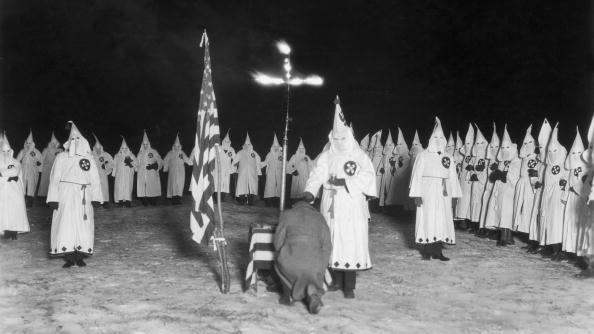How Confederate veterans faced the trauma of defeat and demobilization
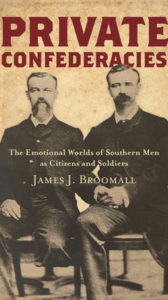
By James J. Broomall
University of North Carolina Press, $29.95
Too often, when we consider Civil War soldiers, we think of what they did, not how they felt. In this compelling work, James J. Broomall invites us to consider their interior lives and how as soldiers and citizens they struggled to make sense of their experiences. While other scholars, such as Gerald Linderman, James McPherson, and Reid Mitchell, have surveyed the motivations of soldiers, Broomall joins a growing number of historians who are focused on questions of masculinity and emotionality.
White Southern men experienced a tension between a public code of behavior that required displays of self-control and a private life that often left them feeling melancholy. The act of keeping diaries, Broomall shows, allowed men to negotiate their feelings and perhaps help control their passions. As soldiers, these men formed deep feelings of mutuality based on unit cohesion. One officer explained that being a soldier “makes us wonderfully selfish & utterly indifferent except to our own immediate comrades: with them we would share our very last cent.”
These soldiers learned literally to strip down to the essentials, to try not to carry too much on the march, and campfires became substitutes for the comforts of home. But deprivation was always on their mind. “We live in dirt,” said one soldier. Focusing on the campaign of the Army of Northern Virginia into Pennsylvania, Broomall shows the contradictory feelings about the battle at Gettysburg, some thrilled to have survived, others shocked at how inured they had become to scenes of death, some convinced that the defeat marked catastrophe, while others refused to succumb to despondency.
Demobilization posed its own challenges. “The war has been going on so long I can’t realize what a man would do now it’s over,” wrote Sergeant J. E. Whitehorne of the Twelfth Virginia Infantry. It comes as no surprise that for many of these white Southerners “reunions, musters, and meeting bolstered a sense of belonging and reinforced a broader corporate identity.” With the Ku Klux Klan, this took a more nefarious turn. Broomall offers an insightful discussion of what he calls the “savage masculinity” of the KKK and how the group’s extralegal violence connected to its members memories of war.
There was no one way in which Confederate veterans dealt with the traumas of war. Some turned inward; some could not cope and committed suicide; others manufactured narratives of the past that helped them move forward; still others found intimacy and gratification in joining extralegal organizations. What Broomall makes clear is that until we examine soldiers’ feelings as fully as their actions, the full impact of the Civil War will continue to elude us. –Louis P. Masur
A Novel Approach to a Battle Story
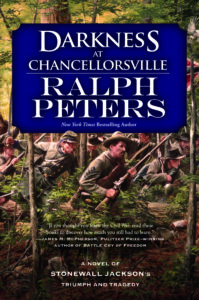
By Ralph Peters
Tom Doherty Associates, $29.99
There are numerous excellent military histories of the Battle of Chancellorsville, such as Stephen Sears’ 1996 account Chancellorsville. Yet, why just read aboutthe battle when Ralph Peters’ meticulously researched, brilliantly imagined historical novel puts readers right in the midst of the battle’s action and lets you actually experienceit? As famed Civil War historian, James McPherson judged: “If you thought you knew the Civil War, read [Peters’] books to discover how much you still had to learn.” Peters’ latest, Darkness at Chancellorsville,is an eagerly anticipated “prequel” to his five award-winning “Battle Hymn Cycle” novels (Cain at Gettysburg, Hell or Richmond,Valley of the Shadow, The Damned of Petersburg, and Judgment at Appomattox) which led readers through the last two years of the war, from the pivotal July 1863 Battle of Gettysburg through Lee’s April 1865 surrender.
Even though anyone remotely familiar with the Civil War undoubtedly knows how the battle evolved and ultimately ended, this compellingly written account keeps readers glued to the book until the last page. Indeed, this blow-by-blow experience of the battle’s progress through the eyes of its participants—from its commanders, Robert E. Lee and “Fighting Joe” Hooker, down to the cavalry, infantry, artillery, engineer and signaler soldiers in blue and gray who endured it—reveals the reality of Civil War combat. Peters brings to life the misery soldiers on both sides endured: torrential rains, knee-deep mud, scorching heat, exhausting marches, nerve-shattering fear, painful wounds, triumph when attacks succeeded, and humiliation when they failed.
Peters brings the war to life through the combat experiences of Union and Confederate enlisted men—all based on actual soldiers—who endured the battle’s horror. Besides bringing Chancellorsville to flesh-and-blood life, Peters weaves in gems on battles, wars and history’s legacy. He explains that his realistic accounts of combat are the result of being “allergic to attempts to romanticize war.” He correctly defines the innocuous military maneuver called a “demonstration”—deploying troops to distract enemy attention from the main attack—as: “a dress parade with corpses.” He has a murderous Confederate Irish soldier explaining: “War didn’t bring out the worst of men….War let men be themselves without fear of the law.” And Peters has Lee revealing one of warfare’s most closely held secrets: “Wars are not won by the most competent army, but by the least incompetent.” Finally, Peters’ observation on today’s social media mob-inspired “rush to judgment” demanding removal/dismantling of Confederate monuments seems spot on: “Today, as Lee’s statues are torn down by a generation gorged on its self-righteousness, his reputation as a soldier endures.” –Jerry D. Morelock
Brain Trust
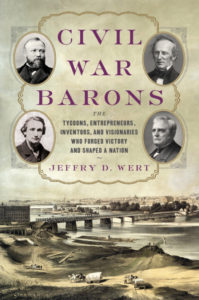
By Jeffry D. Wert
Da Capo Press, $30
William T. Sherman knew it from the beginning.“You are rushing into a war with one of the most powerful, ingeniously mechanical, and determined people on earth—right at your door,” he wrote to a friend in the South during the Secession Winter of 1860-61.“If your people would but stop and think, they must see that in the end you will surely fail.” Sherman understood that war would mobilize the immense industrial capacity of the North and unleash a burgeoning capitalist economy that would eventually overwhelm the South and its limited economic resources.
Jeffry Wert has written thumbnail biographies of 19 of the men behind the men behind the guns, a disparate array of personalities that helped mobilized an entire society and put it on a war footing.While he breaks no new ground with this gallery of budding capitalists, logistical geniuses, and quirky individualists, Wert’s pithy portraits and confident narrative style make for enjoyable and informative reading.When taken together, Wert makes a compelling argument that “[t]he federal government and private enterprises in the North created an organization that linked the resources of the home front to the conduct of military operations and campaigns.” That organization, capably managed and efficiently run, proved superior to anything the Confederacy would devise and often proved the difference between victory and defeat on the battlefield.
The Civil War was the world’s first railroad war and Wert credits John Edgar Thomson and Thomas A. Scott of the Pennsylvania Railroad with marshaling the company’s resources for war and Daniel C. McCallum and Herman Haupt with capably administering the United States Military Rail Road, responsible for railroads in Union-occupied Confederate territory.Edward and Abram Hewitt turned the Trenton Iron Works, founded by Peter Cooper, “into one of the country’s foremost producers of iron rails, wires, and nails.”
The war’s primary means of transportation, however, remained the horse and mule, millions of them.All of them needed to be shod—frequently.Henry Burden, a Scottish immigrant, invented a horseshoe making machine and supplied the War Department with tens of millions of them from his factory in Troy, N.Y.A huge water wheel powered his iron works that reportedly could produce 600 horseshoes per minute.
The war also brought a revolution in firepower.Captain Robert Parker Parrott became superintendent of the West Point Foundry in 1836 and his “innovation in [artillery] design was a wide wrought iron band around the gun’s breech, a distinctive feature of Parrott cannons.”During the antebellum years, the Springfield [Mass.] Armory developed the concept of interchangeable parts, a process the helped New England inventor Christopher Minor Spencer produce his breech-loading repeating rifle and carbine.The Union army was slow to adopt the innovative firearm but a test by President Lincoln accelerated its procurement by the army.Wert rightly concludes that Spencer “invented a weapon that contributed to Union fighting prowess, particularly of cavalry units.”
Some of Wert’s business barons include names familiar to modern consumers.Dr. Edward Robinson Squib pioneered the manufacture of unadulterated pharmaceuticals for the army’s medical corps.Philip Danforth Armour, an innovative entrepreneur, expanded a modest meat and grain business into one of the country’s largest meat packing operations.The army’s enormous need for beef and salt pork led Armour and his partner John Plankton “to adopt methods and machinery that improved efficiency and production.”The war brought a penniless inventor, Gail Borden Jr., and a shrewd investor, Jeremiah Millbank, riches beyond their wildest dreams producing condensed milk for the military.
Riches also befell financier Jay Cooke, the tireless salesman of war bonds that enabled the Union to pay for the war, and enabled Cornelius Vanderbilt to get even richer building steamships and investing in all manner of transportation.Wert also profiles Cyrus McCormick and John Deere.Their agricultural implements helped feed millions of men in uniform, and Gordon McKay made their shoes.War’s end ushered in a new American age, Wert maintains, one of “incalculable possibilities, led, in part, by men shaped by the struggle’s myriad exigencies.” –Gordon Berg
Petersburg: Linchpin of War
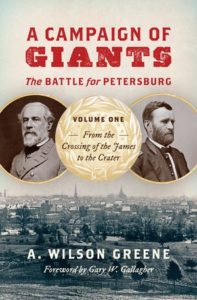
By A. Wilson Greene
University of North Carolina Press, $45
It might seem counterintuitive to say that a book with 516 pages of text and an additional 124 pages of notes and index is tightly written.Yet that is one of Wil Greene’s many accomplishments in this first of a projected three-volume examination of the Eastern Theater’s longest campaign. Greene values the power of words and uses them economically, yet expansively, to explain why Petersburg became the linchpin on which the fate of the Confederacy was ultimately decided.
Petersburg could not have found a more informed champion.Greene has been associated with the Cockade City for most of his professional life, first with the National Park Service and then, for 22 years, as executive director of Pamplin Historical Park and the National Museum of the Civil War Soldier located on the site of the Union breakthrough that, on April 2, 1865, forced the evacuation of Richmond and led to the surrender of the Army of Northern Virginia seven days later.He has repeatedly traversed the ground, familiarized himself with the numerous accounts of the 10-month investment written by soldiers blue and gray, and studied the operational and tactical decisions made by the Civil War’s two most commanding personalities, Robert E. Lee and Ulysses S. Grant.Petersburg was, indeed, a campaign of giants, and it has now found a giant among Civil War historians to render its complexity in language accessible to expert and layman alike.
Greene begins his narrative where the Petersburg Campaign actually began: In the blood-soaked no-man’s land at Cold Harbor.His description and evaluation of Grant’s decision to move south of the James River reveals the strengths and weaknesses of both commanding generals and reminds readers that Grant’s plan, called by Confederate artillerist E. Porter Alexander “the most brilliant stroke in all the Federal campaigns of the whole war,” required first crossing the Chickahominy River, no easy task in itself, and coordinating movements with the 40,000-man Army of the James, commanded by the politically astute, militarily challenged Benjamin Franklin Butler. Butler had already failed to capture a weakly defended Petersburg on June 9, 1864, in an engagement that has come to be known as “The Battle of Old Men and Boys.”Had Butler been successful, the war in the East might have concluded without 10 more months of grinding trench warfare.
Campaign studies often founder on two unavoidable impediments.First, how to describe events occurring simultaneously over a large geographic area using a necessarily linear narrative format and, second, how to visually support the narrative to give the reader a clear sense of time and place?Petersburg imposes both challenges in spades.Greene, for the most part, overcomes them—first, by avoiding the temptation to recite the location of every active unit, instead focusing on those involved in action germane to the overall strategic vision of the two commanders.Also, Greene intersperses his analysis with telling and explanatory anecdotes of contemporary participants; ofttimes allowing them to propel the narrative forward. This is particularly useful at Petersburg because soldiers in both trench lines had time to gather their thoughts and eloquently express them in letters home and in journals tucked away from the elements and keen-eyed snipers.
It’s hard to fault a volume that includes 34 maps, but the complexity and far-flung nature of events during the first months of action at Petersburg cry out for more visual support.Hopefully in succeeding volumes Greene can impose on his friendship with cartographer Edward Alexander for more of his simple, yet always informative, maps.
Greene concludes his first publication with the oft-described July 30 Battle of the Crater, a case study in command ineptitude and soldierly grit.Grant called it “the saddest affair I have witnessed in the war.” There was plenty of blame and recrimination to go around on the Union side and the blood lust exhibited by Confederates against African-American troops callously flung into that pit moved even some graycoats to reassess their humanity.Greene gives a balanced account of the action and makes it a fitting conclusion for his first volume. It will leave the reader anxious for the rest of the story. –Gordon Berg

